

Easing the transition to postsecondary for students with disabilities
Your guide to recently released books, CDs and other teaching resources. For additional reviews of French-language resources, click here. With the exception of some classroom sets, items reviewed are available on loan from the Margaret Wilson Library at the College. Contact Olivia Hamilton at 416-961-8800 (toll-free in Ontario 1-888-534-2222) ext. 679 or e-mail library@oct.ca. |
Protecting and Inspiring Students
Sexual Misconduct in Education
Prevention, Reporting and Discipline
by Grant Bowers, Rena Knox and Justice Marvin A. Zuker
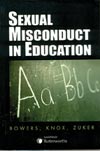 One of the most distressing situations a teacher can face is the suspicion or knowledge that a student is being sexually harassed or abused.
One of the most distressing situations a teacher can face is the suspicion or knowledge that a student is being sexually harassed or abused.
In recent years, society has become much more aware of abuse of students by people in authority and has responded by instituting measures to better protect children. Teachers, principals and school boards are now expected to play key roles in that protection.
Sexual Misconduct in Education is a useful resource for all Ontario educators who want clarification on how to handle suspicions or allegations against a teacher. The authors bring a wealth of experience to the subject. Grant Bowers is legal counsel for the Toronto District School Board and Rena Knox plays the same role for the Catholic Children's Aid Society of Toronto. Justice Marvin A. Zuker is a family court judge and well versed in education law.
The term sexual misconduct encompasses a broad range of behaviour including sexual assault, sexual exploitation and other behaviour that breaches appropriate teacher-student boundaries.
The authors wade through this complex terrain, reviewing the many pieces of legislation that contain mandatory procedures for dealing with sexual misconduct- including the Education Act, Criminal Code, Child and Family Services Act and Ontario College of Teachers Act.
In a historical overview of sexual abuse of children in Canada, the authors cite one of the most important developments in how sexual misconduct is handled today - the 2002 report by former Justice Sydney Robins to the provincial government, Protecting Our Students: A Review to Identify and Prevent Sexual Misconduct in Ontario Schools. The report led to changes in legislation and board policies and procedures to strengthen the education system's ability to prevent sexual harassment and abuse of students.
A large segment of the book is aimed at school administrators who will appreciate the detailed explanations of the process of reporting allegations, the distinct roles of the police and the Children's Aid Societies in investigating, the possible outcomes in criminal court proceedings and how these affect what principals and school boards may and must do in each case.
The book calls particular attention to allegations of sexual assault where police and - if the victim is under 16 - the Children's Aid Society (CAS) would have central roles. But the authors make clear that, even if a teacher is exonerated of criminal acts, he or she might still be guilty of breaching board policies or the College's Professional Misconduct Regulation.
The authors warn against common mistakes such as conducting an investigation before informing the police or CAS, thereby compromising what may become a criminal investigation. Many other questions are also addressed:
- the responsibility of educators to report suspicions of sexual abuse
- school board liability
- false allegations
- actions that may be taken by a school board even if a teacher is found not guilty of criminal wrongdoing
- how to deal with the community's requests for information in a way that respects privacy and retains parent confidence
- how to conduct an internal investigation once any criminal or CAS investigation is completed.
The final chapter is an excellent resource for principals. It provides examples of and appropriate responses to complaints they might receive from students or colleagues of sexual misconduct by a teacher.
![]() Sexual Misconduct in Education, LexisNexis, Markham, Ontario, 2003, ISBN 0-433-44170-4, softcover, 241 pages, $41.00, tel 905-479-2665 or 800-668-6481, fax 905-479-2826 or 800-461-3275, www.lexisnexis.ca/bookstore
Sexual Misconduct in Education, LexisNexis, Markham, Ontario, 2003, ISBN 0-433-44170-4, softcover, 241 pages, $41.00, tel 905-479-2665 or 800-668-6481, fax 905-479-2826 or 800-461-3275, www.lexisnexis.ca/bookstore
Reviewed by Lois Browne, a College senior communications officer, who is responsible for communications related to investigations and hearings.
Assessing Student Understanding in Science
A Standards-Based K-12 Handbook
by Sandra K. Enger and Robert E. Yager
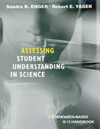 Assessing Student Understanding in Science can help Ontario science educators to better assess science curriculum, teaching and student learning. It is also a resource for curriculum and instructional leaders and teacher educators.
Assessing Student Understanding in Science can help Ontario science educators to better assess science curriculum, teaching and student learning. It is also a resource for curriculum and instructional leaders and teacher educators.
Comprehensive but accessible, this book is packed full of methods for assessing student understanding. Using education research and examples from educators, Enger and Yager have compiled a good sampling of tools and strategies to assess performance in six domains of science: concepts, processes, applications, attitude, creativity and nature of science. The book gives clear rationales and literature to support the what and how of assessing students - something that is often lacking in teacher-support resources.
Chapter 1 provides the research-based overview mentioned above. Chapter 2 examines alternatives to traditional tests, including concept mapping, interviews, portfolios, journal writing and self-assessment. Chapter 3 provides processes for assessing teacher practice. Surveys and checklists are easy to use and align with important teaching goals.
Rubrics and scoring guides are the focus of Chapter 4, with samples easily adapted to fit our Ontario context.
The handbook is aimed at educators using the US National Science Education Standards (NSES). So, some familiarity with the NSES is expected and some tools need to be modified. But the alternative assessments, rubrics, grade-level exemplars and ideas for teachers to evaluate and improve their own curriculum and instruction make the guide easy to adapt. And material for specified grade-level ranges can be modified for use at other levels.
The resource is practical, grounded in effective research-based practices, and is a source of professional ideas that can help move science teachers towards the goal of assessment reform in Ontario - supporting student learning.
![]() Assessing Student Understanding in Science, Corwin Press, Thousand Oaks, California, 2000, ISBN 0-7619-7649-3, softcover, 192 pages, US$37.95, tel 805-499-9774, fax 800-583-2665, www.corwinpress.com
Assessing Student Understanding in Science, Corwin Press, Thousand Oaks, California, 2000, ISBN 0-7619-7649-3, softcover, 192 pages, US$37.95, tel 805-499-9774, fax 800-583-2665, www.corwinpress.com
Reviewed by Xavier Fazio, a science consultant with the Halton Catholic District School Board.
Great Women Leaders
by Heather Ball
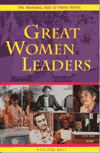 Part of the Women's Hall of Fame series, Great Women Leaders is a collection of stories about 10 accomplished women. The list is diverse - from Hatshepsut to Golda Meir. Their stories span ancient times to the present. They are of different ethnic, cultural, social, spiritual, educational and political backgrounds. They have divergent ideas and ways of approaching the world. Yet, they all question their world. They use intelligence to solve problems and have contributed to our understanding of peace, community, science, politics, the environment and human rights.
Part of the Women's Hall of Fame series, Great Women Leaders is a collection of stories about 10 accomplished women. The list is diverse - from Hatshepsut to Golda Meir. Their stories span ancient times to the present. They are of different ethnic, cultural, social, spiritual, educational and political backgrounds. They have divergent ideas and ways of approaching the world. Yet, they all question their world. They use intelligence to solve problems and have contributed to our understanding of peace, community, science, politics, the environment and human rights.
Heather Ball brings their experiences of struggle and setback, of strength and determination to the forefront. She focuses on their unique perspectives and achievements. She leads the reader to consider a question not-often-enough asked, "What happens when you put women in the story?" - a question that elicits wonderful answers.
Some of their gestures seem, at first glance, to be small - holding onto a seat on a bus or planting a tree - but Ball guides the reader along the path that those choices forged. She brings the stories into the present.
Ball writes with enthusiasm and interest and makes each life real and appealing for both elementary and secondary students. The inclusion of the stories of Wangari Maathai, Aung San Suu Kyi and Roberta Jamieson makes this a distinctive collection that is worthwhile for any classroom teacher who seeks to inspire student activism.
Other titles in the Hall of Fame series are: Fabulous Female Physicians; Amazing Women Athletes; Super Women in Science and Spectacular Women in Space.
![]() Great Women Leaders, Women's Hall of Fame series, Second Story Press, Toronto, 2004, ISBN 1-896764-81-9, softcover, 90 pages, $10.95, tel 416-667-7791, fax 416-667-7832, www.secondstorypress.on.ca
Great Women Leaders, Women's Hall of Fame series, Second Story Press, Toronto, 2004, ISBN 1-896764-81-9, softcover, 90 pages, $10.95, tel 416-667-7791, fax 416-667-7832, www.secondstorypress.on.ca
Reviewed by Nadira Baksh, who teaches part time at the Oxford Learning Centre in Brampton.
Under the Ice
A Marine Biologist at Work
by Kathy Conlan and the Canadian Museum of Nature
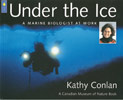 Under the Ice, part of a Canadian Museum of Nature series, is written by Canadian marine biologist Kathy Conlan. In this slim, beautifully illustrated book, Conlan tells the story of how she chose a career in marine biology, where she received her training and what her job involves.
Under the Ice, part of a Canadian Museum of Nature series, is written by Canadian marine biologist Kathy Conlan. In this slim, beautifully illustrated book, Conlan tells the story of how she chose a career in marine biology, where she received her training and what her job involves.
Conlan's account is full of enthusiasm for her work, awe at the ocean's mysteries and joy in her discoveries.
Of particular interest is Conlan's account of her work in Antarctica. Photographs attest to the strikingly beautiful and varied forms of underwater life. A brief chapter on penguins provides entertaining images of these peculiar birds. As with other topics in Under the Ice, facts abound.
Under the Ice will make an excellent purchase for any public or school library and a delightful acquisition for career and guidance libraries. In simple but exact language, Conlan describes her duties as a marine biology researcher. She provides an honest representation of the advantages and drawbacks of the profession (including a frightening account of its dangers). Adults and children alike can learn much. If read only for information on underwater life, this would be a winner, but for its investigation of the life and work of a marine biologist written by a practising Canadian professional, Under the Ice is invaluable.
![]() Under the Ice, Canadian Museum of Nature series, Kids Can Press, Toronto, 2002, ISBN 1-55337-060-0, softcover, 56 pages, $9.95, hardcover, 56 pages, $18.95, tel 416-925-5437 or 800-265-0884, fax 416-960-5437, www.kidscanpress.com, info@kidscan.com
Under the Ice, Canadian Museum of Nature series, Kids Can Press, Toronto, 2002, ISBN 1-55337-060-0, softcover, 56 pages, $9.95, hardcover, 56 pages, $18.95, tel 416-925-5437 or 800-265-0884, fax 416-960-5437, www.kidscanpress.com, info@kidscan.com
Reviewed by Gail Lennon, who teaches distance education online secondary courses for adults with the Bluewater District School Board.
Veux-tu Jouer?
The Prevention and Correction of Errors in French: A Systematic Approach
by Dr. Cher Harvey and Jacquot
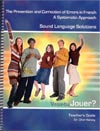
Common grammatical errors are tiresome for teachers of French as a second language (FSL). But how to correct them? Veux-tu jouer? proposes a method that is comprehensive, complete and easy to present.
This book is intended for students who make common errors involving prepositions (je joue du soccer/au soccer), meaning (je suis fini/j'ai fini), pronouns (j'aime celui-là/j'aime celle-là), auxiliary verbs (j'ai allé/je suis allé(e)) and expressions (je visite/je rends visite).
Designed for secondary school immersion teachers, the program assumes that students have a good grasp of basic grammar. The Teacher's Guide helps answer students' questions and is accompanied by one poster and one game for each error. The guide is divided into sections on method, problems and proposed solutions. It also shows how the theory of multiple intelligences can be applied. Most of the material is reproducible, even the words and music of the songs by Jacquot.
The authors' systematic, student-centred approach starts with a pre-test. Students then learn a song intended to correct the most common errors. After completing the exercise sheets, they are ready to play games that apply their new knowledge. Lastly, a test checks that the concept has been well absorbed and the error corrected.
Though the program is designed for secondary school immersion students, it could be used for intermediate-level students as well.
![]() Veux-tu Jouer? Sound Language Solutions, North Bay, 2004, ISBN 0-9734344-1-4, $124.95 (CD, 243-page Teacher's Guide, 8 posters, 240 activity cards), tel 905-562-9172 or 866-262-7777, fax 905-562-9173, www.soundlanguagesolutions.com
Veux-tu Jouer? Sound Language Solutions, North Bay, 2004, ISBN 0-9734344-1-4, $124.95 (CD, 243-page Teacher's Guide, 8 posters, 240 activity cards), tel 905-562-9172 or 866-262-7777, fax 905-562-9173, www.soundlanguagesolutions.com
Reviewed by Shawna Larkey, an FSL teacher with the Simcoe School Board.
Marie Curie
A Brilliant Life
by Elizabeth MacLeod
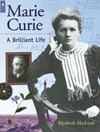 Marie Curie coined the word "radioactive" and discovered the elements radium and polonium. She was the first woman in Europe to earn a doctorate in science and the first woman to win a Nobel Prize. (She won two.) Curie was instrumental in the adoption of X-rays as a medical diagnostic tool.
Marie Curie coined the word "radioactive" and discovered the elements radium and polonium. She was the first woman in Europe to earn a doctorate in science and the first woman to win a Nobel Prize. (She won two.) Curie was instrumental in the adoption of X-rays as a medical diagnostic tool.
This engaging, full-size softcover book is graphically rich and well designed. Each of 13 full-page spreads contains a separate topic as Curie's life is chronicled in text and pictures.
The book is recommended for Grades 3 to 7 and is written in a manner that will resonate with younger readers. It does not delve deeply into the science or theories behind Curie's work, but relationships, struggles, triumphs and tragedies are outlined in a way sure to awaken the interest of the next generation of scientists.
Ontario teachers will find this book most suited to Grade 5 or 7 when presenting matter and materials. But language teachers may find it an inspirational and accessible biography. Secondary teachers may use it in an essentials class or the medical technology unit of SNC 4E.
The book is part of the Snapshots series of biographies that includes Alexander Graham Bell, Lucy Maud Montgomery, the Wright Brothers, Albert Einstein, Helen Keller and the Group of Seven. In support of the series, there is a two-page PDF file of teacher ideas called Breathing Life into Biographies, available on the publisher's web site.
![]() Marie Curie, Kids Can Press, Toronto, 2004, ISBN 1-55337-571-8, softcover, 32 pages, $7.95, tel 416-925-5437 or 800-265-0884, fax 416-960-5437, www.kidscanpress.com, info@kidscan.com
Marie Curie, Kids Can Press, Toronto, 2004, ISBN 1-55337-571-8, softcover, 32 pages, $7.95, tel 416-925-5437 or 800-265-0884, fax 416-960-5437, www.kidscanpress.com, info@kidscan.com
Reviewed by Steve Kennedy, who teaches math, science and computers as a section 20 teacher for the Peel District School Board.
L'Ontario français
Des Pays-d'en-Haut à nos jours
by Gaétan Gervais and Michel Bock
 What is francophone Ontario? Today, after four centuries of evolution, it comprises about half a million people sharing a common language, culture and history. L'Ontario français: Des Pays-d'en-Haut à nos jours traces the development of this community and the Franco-Ontarian identity.
What is francophone Ontario? Today, after four centuries of evolution, it comprises about half a million people sharing a common language, culture and history. L'Ontario français: Des Pays-d'en-Haut à nos jours traces the development of this community and the Franco-Ontarian identity.
Designed for Grade 12 history students, L'Ontario français outlines the conflicts, struggles, crises, upheavals and victories in this evolving community. Each chapter concludes with a series of questions for further study and an exhaustive bibliography, inviting readers to continue their exploration.
The accompanying Teachers' Guide provides paratexual markers such as Portraits, Villes et villages, Témoignages and Retour aux sources that will give students a better grasp of the remarkable history of the Franco-Ontarian people - a people still engaged in asserting their rights, minimizing assimilation and meeting the challenges of surviving and thriving in a predominantly anglophone environment.
The author traces the development of education in the province from 1786 through the great reforms of the 1840s and Regulation 17 to the creation in 1998 of the current 12 French-language school boards.
The chapter Les « franco-ontariens » depuis 1960 focuses on the events, groups and individuals who played a role in creating a new Franco-Ontarian identity between 1960 and 2000. It highlights activities in the arts, as well as the introduction of the Franco-Ontarian flag in 1975 and its adoption by the Legislative Assembly as an official emblem in 2001.
The guide is specifically geared to the ministry's CHF40 course outline, enabling teachers to link the thematic approach of the curriculum to the textbook's chronological organization. The guide offers a variety of activities for students, as well as print, electronic and audiovisual resources.
This textbook deserves a place on the shelves of history teachers and anyone interested in the history and stories of francophone Ontario.
![]() L'Ontario français, Centre franco-ontarien de ressources pédagogiques, Ottawa, 2004, ISBN 2-89581-219-5, hardcover, 272 pages, $35 / guide, 278 pages, $50, 613-747-8000 or 877-747-8003, www.librairieducentre.com
L'Ontario français, Centre franco-ontarien de ressources pédagogiques, Ottawa, 2004, ISBN 2-89581-219-5, hardcover, 272 pages, $35 / guide, 278 pages, $50, 613-747-8000 or 877-747-8003, www.librairieducentre.com
Reviewed by College Chair Marilyn A. Laframboise, who teaches at École Ste-Ursule in McGregor and has lived in Essex County's vibrant francophone community all her life.
Manya's Dream
A Story of Marie Curie
by Frieda Wishinsky
Illustrations by Jacques Lamontagne
 In this book Marie Curie's story is told by a Polish immigrant mother when her young daughter expresses frustration at having no friends and at being teased about her lack of English in a new school, in a new country. She tells her daughter the tale of another young woman who left behind family and homeland, and who, with determination and hard work, overcame many challenges and sorrows to follow her heart and mind into a life of scientific exploration and discovery.
In this book Marie Curie's story is told by a Polish immigrant mother when her young daughter expresses frustration at having no friends and at being teased about her lack of English in a new school, in a new country. She tells her daughter the tale of another young woman who left behind family and homeland, and who, with determination and hard work, overcame many challenges and sorrows to follow her heart and mind into a life of scientific exploration and discovery.
Although born in Warsaw, Manya had to leave in order to continue her studies, as Polish girls were not permitted entry into university at that time. She moved to Paris, adopted the French form of her name, Marie, and later married Pierre Curie. She became the first woman to win a Nobel Prize and, later, the first person ever awarded the prize in two different areas of science - physics and chemistry.
Beautifully illustrated by Jacques Lamontagne, Manya's Dream will be welcome in any K - 8 class. Schools wishing to build their character-education library will value the messages - courage, integrity, empathy, perseverance - incorporated throughout the story. ESL educators will find that its tale shows empathy for the student who has entered a classroom in a new land and faces many challenges, including learning a new language.
Teachers who seek stories about women who trail-blazed for subsequent generations will appreciate the chronology of important dates provided at the back of the book. Manya's Dream is also a suitable companion for the Grade 8 teacher who seeks to complement curriculum in women's historic roles, World War I history and messages of peace.
![]() Manya's Dream, Maple Tree Press, Toronto, 2003, ISBN 1-894379-54-3, softcover, 32 pages, $6.95, ISBN 1-894379-53-5, hardcover, 32 pages, $19.95, distributed by Firefly Books, tel 416-499-8412 or 800-387-6192, fax 416-499-8313 or 800-450-0391, www.fireflybooks.com
Manya's Dream, Maple Tree Press, Toronto, 2003, ISBN 1-894379-54-3, softcover, 32 pages, $6.95, ISBN 1-894379-53-5, hardcover, 32 pages, $19.95, distributed by Firefly Books, tel 416-499-8412 or 800-387-6192, fax 416-499-8313 or 800-450-0391, www.fireflybooks.com
Reviewed by Helen Bajorek MacDonald, who is a writer and an Intermediate teacher with Kawartha Pine Ridge District School Board.
Stage It!
Three Plays and a Monologue
Written and compiled by Christine Harvey
Illustrated by Isaac Gillis
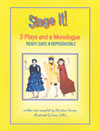 The three plays and the monologue referred to in the title of this book are: A Look All Her Own: A Modern Cinderella Story; The Legend of the Lost and Found Box; A Fairytale Medley; and The Phone Call. All of these productions are well suited for an elementary classroom and can be performed as simply or elaborately as the director requires. They are suitable for a small cast yet could easily incorporate additional players.
The three plays and the monologue referred to in the title of this book are: A Look All Her Own: A Modern Cinderella Story; The Legend of the Lost and Found Box; A Fairytale Medley; and The Phone Call. All of these productions are well suited for an elementary classroom and can be performed as simply or elaborately as the director requires. They are suitable for a small cast yet could easily incorporate additional players.
The message behind each production is unique but all address up-to-date issues that students can relate to.
The illustrations are a welcome change from those in traditional books about plays and create a piece of literature that resembles a picture book. Not only can these plays be performed, they also allow educators to expand the genre of literature in classroom and/or school libraries. Students will enjoy reading the book as much as acting its plays.
This book can be used by specialists such as drama teachers, English teachers and librarians, but would be an equally welcome resource for any classroom teacher. Overall, a terrific book that should be in every teacher's hand.
![]() Stage It! Trafford Publishing, Victoria, BC, 2003, ISBN 1-4120-1098-5, softcover, 77 pages, $19.99, tel 888-232-4444, fax 250-383-6804, www.trafford.com
Stage It! Trafford Publishing, Victoria, BC, 2003, ISBN 1-4120-1098-5, softcover, 77 pages, $19.99, tel 888-232-4444, fax 250-383-6804, www.trafford.com
Reviewed by Maureen Doeler, a Grade 6 teacher in Simcoe County.
The Giant Encyclopedia of Kindergarten Activities
Edited by Kathy Charner, Maureen Murphy and Jennifer Ford
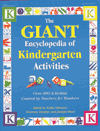 This is a comprehensive compilation of over 600 activities used by teachers in their classrooms and is one resource that no Kindergarten teacher should be without.
This is a comprehensive compilation of over 600 activities used by teachers in their classrooms and is one resource that no Kindergarten teacher should be without.
The Table of Contents includes Ontario Curriculum Strands, such as math, literacy and science, as well as categories such as Blocks, Circle Time, Outdoor Play and Gross Motor, to name a few.
Each activity is organized according to Materials Needed, What to Do, More to Do and Related Books, Songs and Poems. Most of the materials needed for the activities are already found in a Kindergarten classroom. A busy teacher need not search high and low in order to prepare for the activities. There is even a recipe for making silly putty!
The Encyclopedia also includes a 23-page Literature List of popular children's books. The list is arranged in alphabetical order by book title and includes the author's name and theme(s).
The Giant Encyclopedia of Kindergarten Activities will certainly be a welcome addition to any busy teacher's resource collection.
![]() The Giant Encyclopedia of Kindergarten Activities, Gryphon House, Beltsville, Maryland, 2004, ISBN 0-87659-285-X, softcover, 560 pages, $45.95, tel 301-595-9500, fax 301-595-0051, distributed by Monarch Books, tel 416-663-8231 or 416-736-1702, www.monarchbooks.ca
The Giant Encyclopedia of Kindergarten Activities, Gryphon House, Beltsville, Maryland, 2004, ISBN 0-87659-285-X, softcover, 560 pages, $45.95, tel 301-595-9500, fax 301-595-0051, distributed by Monarch Books, tel 416-663-8231 or 416-736-1702, www.monarchbooks.ca
Reviewed by Bonnie Caminiti, who teaches at St. Leonard School with the Ottawa-Carleton Catholic School Board.
Funtime Riddles, Recess Riddles
by Marilyn Helmer and Jane Kurisu
Illustrated by Jane Kurisu
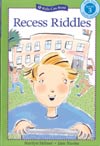
 Part
of the Kids Can Read Alone series, these two riddle books will provide
enjoyment and amusement while children learn linguistic concepts and
practise reading skills. Children who can read independently in Grades
1 to 3 - the group these books are aimed at - will enjoy reading the
riddles to others to see if they can guess the answers.
Part
of the Kids Can Read Alone series, these two riddle books will provide
enjoyment and amusement while children learn linguistic concepts and
practise reading skills. Children who can read independently in Grades
1 to 3 - the group these books are aimed at - will enjoy reading the
riddles to others to see if they can guess the answers.
Most of the riddles play with language. A large portion includes puns with the "groan quotient" that so appeals to this age group. Example: "Why couldn't the sailors play cards on the boat? Because the captain was standing on the deck." Children learn that words can have more than one meaning and that context in language is very important. Another linguistic trick used is changing words by changing letters, e.g. "Which day of the week can you chew gum in school? Chews-day."
Riddles in Recess Riddles relate to school while those in Funtime Riddles pertain to sports and games. The text is large and easy to read, while delightful colour cartoons provide visual clues to the written words. You may wish to purchase the hardcover version of these books as I anticipate they will get heavy usage. Highly recommended.
![]() Funtime Riddles, Recess Riddles, Kids Can Read Alone series, Kids Can Press, Toronto, 2004, ISBN 1-55337-580-7 (Funtime), ISBN 1-55337-578-5 (Recess), softcover, 32 pages, $5.95, hardcover $14.95, tel 416-925-5437 or 800-265-0884, fax 416-960-5437, www.kidscanpress.com, info@kidscan.com
Funtime Riddles, Recess Riddles, Kids Can Read Alone series, Kids Can Press, Toronto, 2004, ISBN 1-55337-580-7 (Funtime), ISBN 1-55337-578-5 (Recess), softcover, 32 pages, $5.95, hardcover $14.95, tel 416-925-5437 or 800-265-0884, fax 416-960-5437, www.kidscanpress.com, info@kidscan.com
Reviewed by Margaret Grift, a librarian at Brantford Christian School in the Simcoe Muskoka Catholic District School Board.
Fun Times
Board Game
by Thérèse Paquet
 At last! Fun Times is a math game that lives up to its name and actually turns the dreaded practising of times tables into fun. Until now, the only resources available for this tedious but oh-so-necessary exercise were flash cards, photocopied tables and drills, drills and more drills.
At last! Fun Times is a math game that lives up to its name and actually turns the dreaded practising of times tables into fun. Until now, the only resources available for this tedious but oh-so-necessary exercise were flash cards, photocopied tables and drills, drills and more drills.
The game has 12 boards (one for each times table). Students can answer the questions at their own pace or use an hourglass timer to answer more quickly. Tiny quiz booklets are included for drills after the players have played each board correctly. Fun Times is an excellent activity to motivate students to learn.
The instructions are clear and the game can be played by individuals or in small groups. An instruction sheet for parents means that the game can be sent home with students who have particular difficulty. This is an excellent Canadian-made resource that really will make practising times tables "fun times."
![]() Fun Times, Fun Times Educational Games, $29.95, 514-804-0087, www.funtimesgames.com, info@funtimesgames.com, orders@funtimesgames.com
Fun Times, Fun Times Educational Games, $29.95, 514-804-0087, www.funtimesgames.com, info@funtimesgames.com, orders@funtimesgames.com
Reviewed by Esther Tolooei, a Grades 1 and 2 teacher at Temple Christian Academy in Sarnia.







